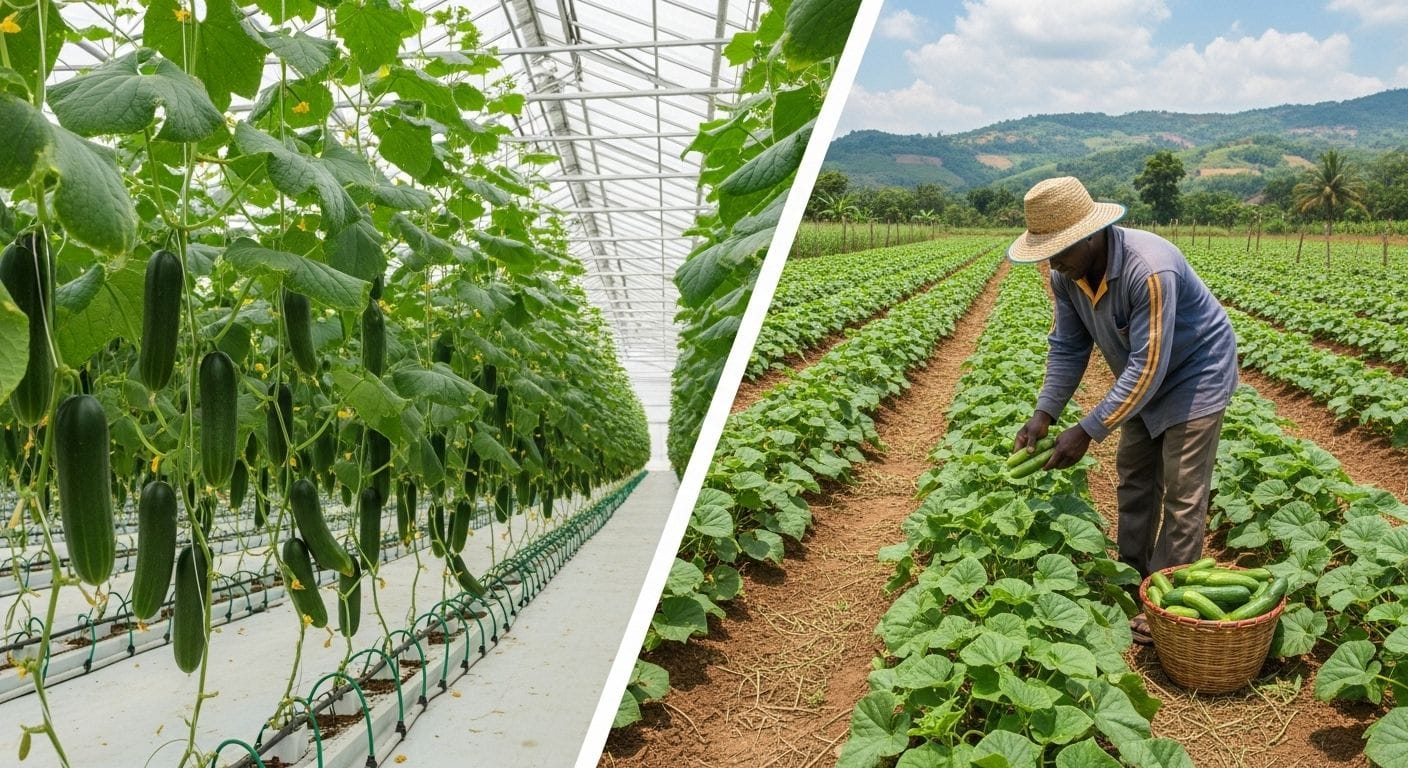Your Complete Guide to Profitable Cucumber Farming in Ghana: Greenhouse vs. Open Field
Cucumber cucumber farming in ghana Ghana is rapidly emerging as a highly lucrative agricultural venture, promising significant returns within a short period. For aspiring entrepreneurs, it offers a tangible opportunity to generate substantial income, with some Ghanaian farmers reporting monthly earnings of up to GHS 25,000 from just one acre. This complete step-by-step guide for entrepreneurs breaks down everything you need to know to launch your own successful operation, covering crucial decisions like greenhouse vs. open-field cultivation and robust pest control strategies.
Why is Cucumber Farming a Profitable Venture in Ghana?
The demand for fresh cucumbers is consistently high in Ghana, driven by hotels, restaurants, grocery stores, and local markets. The crop’s short growth cycle—often ready for harvest in as little as 45-60 days—allows for a quick return on investment. With proper management, it’s possible to start a small-scale farm with a modest investment (as low as GHS 1,000) and scale up as you gain experience and capital. Studies show that cucumber farming can achieve a profit margin of over 55%, making it one of the most attractive options in modern Ghanaian agriculture.
Choosing Your Method: Greenhouse vs. Open-Field Farming
One of the first major decisions an entrepreneur must make is the cultivation method. Both greenhouse and open-field farming have distinct advantages and disadvantages in the Ghanaian context.
Greenhouse Farming
- Advantages: Offers year-round production regardless of weather conditions, provides superior protection from pests and diseases, allows for precise control over irrigation and nutrients (often using drip systems), and typically yields higher-quality, blemish-free produce that commands a premium price.
- Disadvantages: Requires a significantly higher initial capital investment for construction and setup. Management requires a higher level of technical knowledge, especially for controlling temperature and humidity.
Open-Field Farming
- Advantages: Far lower start-up cost, making it accessible for entrepreneurs with limited capital. Relies on natural rainfall and sunlight, reducing operational complexity.
- Disadvantages: Highly susceptible to weather fluctuations, pests, and diseases. Yields can be lower and less consistent. Produce may be more prone to damage and blemishes, potentially fetching lower market prices.
For entrepreneurs aiming for the premium export or high-end local market, a greenhouse is the superior choice. For those starting with minimal capital, open-field farming is a viable entry point.
A Complete Step-by-Step Guide for Entrepreneurs in Ghana
Following a structured approach is key to success. Here is a breakdown of the essential stages, from seed to sale.
Step 1: Choose the Right Cucumber Variety
Selecting a high-yield, disease-resistant variety suitable for Ghana’s climate is crucial. Popular and effective varieties include:
- Marketmore 76: A reliable slicing cucumber known for its high yield and strong disease resistance.
- Straight Eight: Prized for its uniform, crisp, and sweet fruits, making it ideal for the fresh market.
- Diva: An English-type cucumber with thin, tender skin and a seedless interior, often preferred for salads.
- Poinsett: A widely grown variety in Ghana, known for its good performance in local conditions.
Step 2: Land Selection and Soil Preparation
Cucumbers thrive in well-drained, fertile soil rich in organic matter. Follow these preparation steps:
- Select a Site: Choose a location that receives at least 6-8 hours of direct sunlight daily.
- Test Your Soil: Aim for a soil pH between 6.0 and 7.0. A soil test will reveal nutrient deficiencies.
- Clear and Till the Land: Remove all weeds, rocks, and debris. Till the soil to a depth of 8-12 inches to improve aeration and create a fine texture.
- Incorporate Organic Matter: Add well-decomposed compost or animal manure to enrich the soil, improve its structure, and boost water retention.
Step 3: Seed Selection and Planting
Always source high-quality seeds from reputable suppliers to ensure a high germination rate and vigorous plants.
- Seed Treatment: To prevent soil-borne diseases like damping-off, consider using seeds treated with a fungicide. Soaking seeds in water for 12-24 hours can also speed up germination.
- Sowing: Plant seeds about 1 inch deep. In open fields, space rows 3-4 feet apart, with plants spaced 4-6 inches apart within the row. Water gently immediately after planting.
Step 4: Irrigation and Nutrient Management
Consistent moisture and balanced nutrition are non-negotiable for a healthy crop.
- Irrigation: Cucumbers are about 95% water and require consistent moisture, especially during flowering and fruiting. Drip irrigation is the most efficient method as it delivers water directly to the roots and avoids wetting the leaves, which can promote fungal diseases. Avoid overhead watering.
- Fertilization: A balanced NPK (Nitrogen-Phosphorus-Potassium) fertilizer is essential. A common recommendation for cucumbers is a ratio of 2:1:1.
- Nitrogen (N): Promotes healthy, green leafy growth.
- Phosphorus (P): Crucial for root development and flowering.
- Potassium (K): Essential for fruit development and overall disease resistance.
Step 5: Comprehensive Pest and Disease Control for Cucumber Farming in Ghana
Pest management is one of the biggest challenges and is vital for a profitable harvest. An Integrated Pest Management (IPM) approach is highly recommended.
Common Pests in Ghana
The most devastating pests for cucumber and other cucurbits in Ghana are fruit flies. According to research, species like the Oriental fruit fly (Bactrocera dorsalis) and the Melon fruit fly (Zeugodacus cucurbitae) can cause yield losses of up to 95% if not managed. Other common pests include aphids, spider mites, and cucumber beetles.
Integrated Pest Management (IPM) Strategies
- Cultural Control: This is your first line of defense. Practice good farm sanitation by regularly collecting and destroying any fallen or infested fruits. This breaks the life cycle of fruit flies. Timely harvesting also reduces the window for infestation.
- Male Annihilation Technique (MAT): Set up traps using parapheromones (like Methyl Eugenol for Bactrocera dorsalis) to attract and kill male fruit flies, disrupting their breeding cycle. Use about 5 traps per acre for best results.
- Bait Application Technique (BAT): Use food baits (protein or sugar-based) mixed with a low-toxicity insecticide like Spinosad. Apply this mixture as spot sprays on plant leaves. It attracts and kills both male and female flies.
- Biological Control: Introduce or encourage natural enemies. Entomopathogenic fungi like Metarhizium anisopliae can be applied to the soil to kill pupating larvae. While less common commercially, some farmers use ducks for pest control, as they forage for slugs, beetles, and other ground insects. However, they can also cause crop damage by trampling vines.
- Chemical Control: Use pesticides as a last resort. Choose biopesticides like neem oil for common pests like aphids and mites. For severe fruit fly infestations, targeted application of approved insecticides may be necessary. Always follow the manufacturer’s instructions and observe pre-harvest intervals.
Step 6: Training, Pruning, and Pollination
- Training: To save space, improve air circulation, and keep fruits off the ground, train cucumber vines to grow on a trellis or stake system. This practice is standard in greenhouse production and highly recommended for open fields to produce cleaner, higher-quality fruit.
- Pruning: Remove excess side shoots (suckers) and old, damaged, or yellowing leaves. This directs the plant’s energy towards fruit production and further improves airflow, reducing disease risk.
- Pollination: Cucumbers require pollination to produce fruit. Bees are the primary pollinators. To attract them, avoid using harmful pesticides, and consider planting companion flowers like marigolds near your farm. In greenhouses where pollinators may be absent, hand-pollination may be necessary for non-parthenocarpic (non-self-pollinating) varieties.
Step 7: Harvesting and Post-Harvest Handling
- Harvesting: Cucumbers are typically ready for harvest 45-60 days after planting. Harvest them when they are firm, green, and have reached the desired size for your target market. Harvest early in the morning. Use a sharp knife or shears to cut the stem, leaving a small piece attached to the fruit.
- Post-Harvest: Cool the cucumbers immediately after harvest to slow ripening and preserve freshness. Clean, sort, and grade them based on size and quality. Proper packaging is essential to protect the produce from damage during transport.
Step 8: Cost Analysis and Marketing Your Produce
A successful business requires a solid financial plan. Here is a simplified cost and marketing overview.
Potential Costs
- Land lease/preparation
- Seeds
- Fertilizers and manure
- Pest control (traps, baits, pesticides)
- Irrigation system (e.g., drip lines, water pump)
- Trellising materials
- Labor (planting, weeding, harvesting)
- Packaging and transportation
Marketing Strategy
- Identify Your Market: Before you plant, know who you will sell to. Potential buyers include local market traders, supermarkets, hotels, restaurants, and processing companies.
- Build Relationships: Network with potential buyers early. Supplying samples can help secure future contracts.
- Branding and Packaging: Good packaging not only protects your produce but also creates a brand identity that can attract premium customers.
- Price Competitively: Set your prices based on your production costs, produce quality, and current market rates.
By following this guide on how to start a profitable cucumber farming venture in Ghana, aspiring entrepreneurs can effectively navigate the challenges of cultivation, pest control, and marketing to build a thriving agricultural business that contributes to both their income and the nation’s food security.











